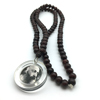Yoga: The Science of the Soul

Yoga: The Science of the Soul
Book
Much of what is known today as yoga emphasizes physical postures and exercises to increase flexibility and help relaxation. But, in fact, yoga has its roots in the understanding of human consciousness and its potential, which was developed over centuries of rigorous investigation and research in the East.
In Yoga Osho explains the meaning of some of the most important Yoga Sutras of Patanjali, an early "scientist of the soul" who is credited with being the father of Raja Yoga, or the "royal path" of yoga. Raja Yoga uses physicl postures and breath primarily as a means to achieve higher states of consciousness. Here is a fresh translation of these ancient texts, and Osho’s unique insights into the modern mind and its psychology. Patanjali comes to life on these pages with an approach to using yoga for greater self-understanding that is absolutely relevant to our times.
This book is an invaluable resource for either beginning or experienced yoga practitioners, and for anyone who seeks a better understanding of the intricate and powerful relationship that exists between body and mind.
Chapter Titles
#1: Now the Discipline of Yoga
#2: The Five Modifications of the Mind
#3: Constant Effort Is the Key
#4: The Eight Steps
#5: Posture and Breath
#6: Yoga in the Fast Lane
Responses to Questions
Details
A selection of five talks from the classic ten-volume series illuminating Patanjali’s yoga sutras, plus selected responses to questions.
Excerpt from: Yoga, The Science of the Soul, Chapter 5
"Patanjali’s yoga has been very much misunderstood and misinterpreted. Patanjali is not a gymnast, but yoga looks like it is a gymnastics of the body. Patanjali is not against the body. He is not a man to teach you contortions of the body. He teaches you the grace of the body, because he knows only in a graceful body a graceful mind exists; and only in a graceful mind a graceful self becomes possible; and only in a graceful self, the beyond.
"Step by step, a deeper and higher grace has to be attained. Grace of the body is what Patanjali calls asan, posture. He’s not a masochist. He is not teaching you to torture your body, he is not a bit against the body. How can he be? He knows the body is going to be the very foundation stone. He knows that if you miss the body, if you don’t train the body, then higher training will not be possible.
"The body is just like a musical instrument. It has to be rightly tuned; only then will the higher music arise out of it. If the very instrument is somehow not in a right shape and order, then how can you imagine or hope that the great harmony will arise out of it? Only discordance will arise. The body is a veena, a musical instrument.
"The posture should be steady and should be very, very blissful, comfortable. So never try to distort your body and never try to achieve postures that are uncomfortable.
"For the Westerners, sitting on the ground, sitting in padmasan, the lotus posture, is difficult. Their bodies have not been trained for it. There is no need to bother about it! Patanjali will not force that posture on you. In the East, from their very birth people are sitting in this way, small children are sitting on the ground. In the West, in all the cold countries, chairs are needed; the ground is too cold. But there is no need to be worried about it. If you look at Patanjali’s definition of what a posture is, you will understand: It should be steady and comfortable.
"If you can be steady and comfortable in a chair, it is perfectly okay – no need to try a lotus posture and force your body unnecessarily. In fact, if a Western person tries to attain to the lotus posture it takes six months to force the body – and it is a torture. There is no need. Patanjali is not in any way trying to help or persuade you to torture the body. You can sit in a tortured posture, but then it will not be a posture according to Patanjali.
"A posture should be such that you can forget your body. What is comfort? When you forget your body, you are comfortable. When you are reminded continuously of the body, you are uncomfortable. So whether you sit in a chair or you sit on the ground, that’s not the point. Be comfortable, because if you are not comfortable in the body you cannot long for other blessings that belong to deeper layers. The first layer missed, all other layers are closed. If you really want to be happy, blissful, then start from the very beginning to be blissful. Comfort of the body is a basic need for anybody who is trying to reach inner ecstasies.
"Posture should be steady and comfortable.
And whenever a posture is comfortable it is bound to be steady. You fidget if the posture is uncomfortable. You go on changing sides if the posture is uncomfortable. If the posture is really comfortable, what is the need to fidget and feel restless and go on changing again and again?
"And remember, the posture that is comfortable to you may not be comfortable to your neighbor; so please, never teach your posture to anybody. Every body is unique. Something that is comfortable to you may be uncomfortable to somebody else.… " Osho
Details
More Information
Type Abridged Product
Publisher St. Martins Press, USA
ISBN-13 312306148
Dimensions (size) 140 x 216 mm
Number of Pages 224
- Log in to post comments
- 377 views
